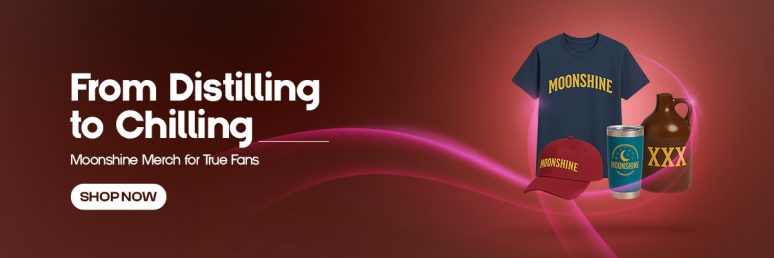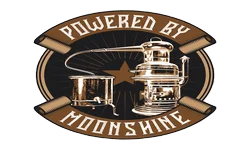Aging Moonshine Guide: Glass vs. Oak and Their 4 Major Differences
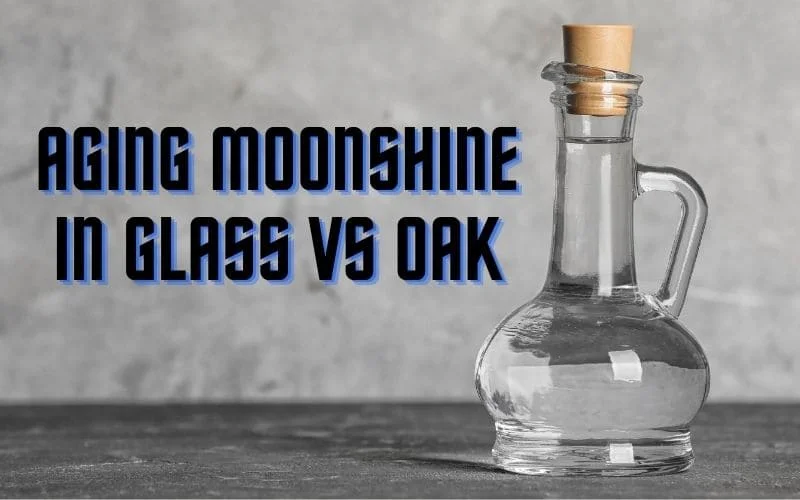
Key Takeaways
- Aging moonshine in oak introduces complex flavors like vanilla and caramel while glass aging with wood chips offers more control over the flavor profile
- The ideal aging proof for moonshine is around 65% ABV (130 proof), which extracts optimal wood compounds
- Glass containers with wood chips are perfect for beginners while small oak barrels accelerate aging due to higher wood-to-spirit ratios
- Different woods beyond oak (like apple, cherry, and maple) can create unique flavor profiles in your homemade spirits
- Using a glass jar with toasted oak dominoes allows for frequent taste testing to monitor your moonshine’s evolution
Transforming harsh, clear moonshine into a smooth, flavorful spirit isn’t just about patience—it’s about understanding the science of aging and choosing the right vessel for your goals. Whether you’re working with store-bought white whiskey or legally produced homemade spirits, the aging process makes all the difference between a throat-burning experience and a sippable delight.
What Really Happens When You Age Moonshine
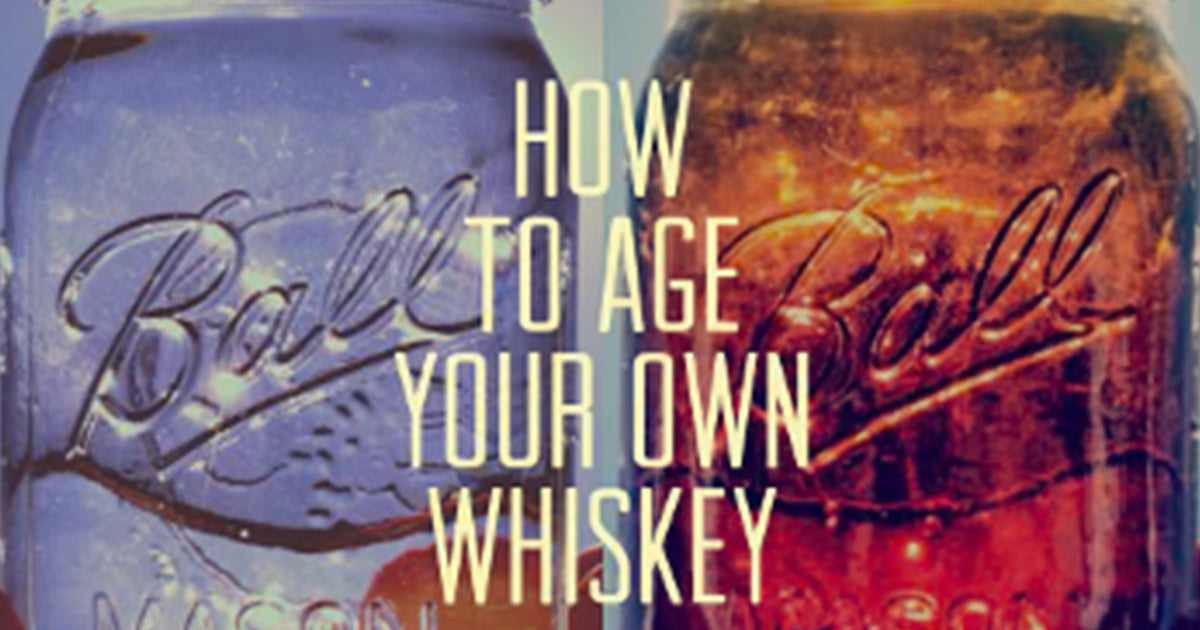
“How to Make Your Own Aged Whiskey” from www.clawhammersupply.com and used with no modifications.
When fresh moonshine meets wood, magic happens. The high-proof spirit extracts compounds from the wood including lignins, tannins, and hemicellulose, which transform into flavors ranging from vanilla and caramel to spice and smoke. Chemical reactions between the alcohol and these compounds create entirely new flavor molecules not present in either the original spirit or the wood. During aging, harsh alcohols convert to esters, which provide fruity notes, while the spirit’s rough edges smooth out through oxidation.
Many beginners make the mistake of thinking any aging will improve their moonshine. The truth is that wood won’t fix fundamental flaws in your distillation. If you start with poorly made spirits containing excessive methanol or fusel oils, no amount of barrel time will save it. Starting with clean, well-made moonshine is essential.
Most importantly, aging isn’t a passive process—it’s a relationship between your spirit and its container that requires monitoring and adjustment. The best home aging projects involve regular tasting and documentation to track development and prevent over-extraction of wood flavors. We’re glad to refer you to “must-have moonshine accessories and supplies” we always recommend.
Glass vs. Oak: The 4 Critical Differences
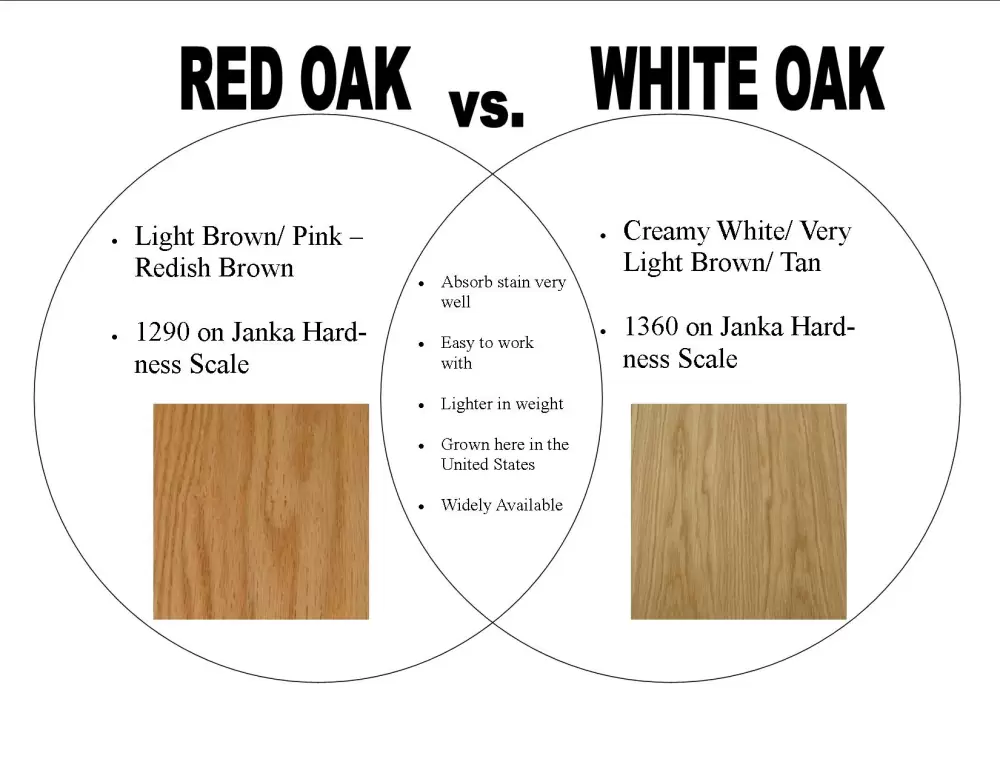
“Red Oak vs. White Oak – The Ultimate …” from www.stair-treads.com and used with no modifications.
When deciding between glass containers with wood additions versus traditional oak barrels, understanding their fundamental differences will help you make the right choice for your aging project. Each method creates distinctly different results through varying chemical and physical processes. For more insights, you can explore a discussion on at home aging practices.
1. Flavor Development
Oak barrels provide a complete aging environment where your moonshine interacts with wood through direct contact and micro-oxygenation through the barrel staves. The porous nature of wood allows tiny amounts of oxygen to enter, triggering oxidation reactions that develop complex flavor compounds. This creates rounded, integrated flavors with subtlety and depth that’s difficult to replicate with other methods.
Glass containers with wood chips or staves offer more controlled flavor extraction. The spirit only interacts with the specific wood surfaces you’ve added, and extraction happens primarily through direct contact rather than the dynamic exchange found in barrels. While this approach can create strong wood flavors quickly, it sometimes lacks the complexity and integration of barrel aging.
The difference becomes most noticeable in longer aging projects. Short-term aging (1-3 months) shows minimal differences between methods, but beyond 6 months, barrel-aged spirits typically develop more nuanced flavors while glass-aged spirits with wood additions can become one-dimensional if not carefully managed.
2. Oxygen Exchange
Barrels breathe. Their porous structure allows minimal oxygen to permeate the wood and interact with the spirit inside, which catalyzes critical chemical reactions. This micro-oxygenation helps convert harsh alcohols to smoother compounds and allows volatile compounds to escape gradually. The breathability of barrels creates what distillers call the “angel’s share”—a small percentage of spirit that evaporates through the wood each year. For those interested in experimenting with flavors, you might explore recipes like grape moonshine to see how different ingredients interact with the aging process. We’re happy to refer you to “premium moonshine ingredients” we highly recommend for bold flavor.
Glass containers are essentially airtight environments, especially with sealed lids. Without oxygen exchange, your moonshine develops differently, often retaining more of its original character while taking on wood flavors. Some home distillers use coffee filters instead of tight lids to allow minimal breathing with glass containers, approximating barrel conditions.
3. Color Transformation
Oak barrels transform clear moonshine into amber or deep brown spirits through natural pigments and tannins in the wood. This color change happens gradually as the spirit penetrates the wood’s surface layers and extracts compounds. Charred barrels accelerate this process, with the carbon layer acting as both a filter and color source. The resulting color isn’t just aesthetic—it indicates the chemical changes happening in your spirit. For those interested in exploring different flavors, you might want to try making a pear moonshine mash recipe.
Glass aging with wood chips can also produce color changes, but often less consistently. The limited wood surface area and lack of pressure dynamics mean color develops differently, sometimes creating a lighter or less uniform appearance. Many home distillers compensate by toasting or charring their wood additions more heavily to boost color extraction, though this can sometimes create imbalanced flavors.
4. Aging Timeline
Perhaps the most practical difference between methods is time. Small oak barrels (1-5 liters) can age spirits remarkably quickly—sometimes achieving in months what would take years in full-sized barrels. This rapid aging occurs because of the higher wood-to-spirit ratio and increased surface contact. A 2-liter barrel might create noticeable oak character in just 2-4 weeks, while the same volume in glass with wood chips might take 1-3 months for similar intensity.
Glass container aging offers more predictability and control but typically requires more patience. The lack of natural pressure changes and oxygen exchange means flavor development follows a more linear path. Temperature fluctuations affect both methods but impact barrels more dramatically, as the wood expands and contracts, forcing spirit deeper into the grain.
Glass Container Aging: The Complete Picture

“How to Distress and Age New Glass …” from overthebigmoon.com and used with no modifications.
For many home enthusiasts, glass containers represent the most accessible entry point into aging spirits. They’re affordable, reusable, and allow you to closely monitor your moonshine’s development without commitment to a full barrel. When paired with properly prepared wood additions, they can produce excellent results.
Pros of Glass Storage
Glass containers provide unmatched clarity in your aging process—both literally and figuratively. You can observe color changes in real-time and easily remove wood pieces once you’ve achieved your desired flavor profile. They’re chemically neutral, meaning they won’t impart any flavors of their own or react with your spirit. This neutrality allows you to focus entirely on the wood’s contribution.
Cost efficiency is another major advantage. While quality barrels can cost $50-150 even in small sizes, glass containers with wood additions might total $15-30 for the same volume. This affordability makes experimentation much more accessible, allowing you to try different wood types, toast levels, and char intensities without significant investment.
Best Spirits for Glass Aging
Not all spirits benefit equally from glass container aging. Clear, unaged whiskeys and corn-based moonshines respond particularly well to this method, quickly absorbing vanilla, caramel and oak notes from wood additions. The high proof typical of these spirits (often 100-140 proof) efficiently extracts flavor compounds from wood surfaces. For those interested in exploring different flavors, you might want to try a blueberry moonshine recipe as a unique option.
Vodka experiments with wood chips can help you isolate specific wood flavors, but won’t create the same depth as aging grain-based spirits. As one experienced distiller notes, “You are not going to age vodka and get an aged bourbon or rye equivalent—the core flavors of those whiskies come from the grains that they ferment from.” The best candidates are spirits with character of their own that can be enhanced rather than dominated by wood.
Glass Container Types and Recommendations
The ideal glass container provides adequate volume, a wide mouth for adding and removing wood pieces, and either a secure seal or breathable closure option. Mason jars work well for small experimental batches (1-2 liters), while larger glass carboys or demijohns serve better for bigger projects. Some home distillers prefer vessels with spigots for easy sampling without disturbing sediment that may develop.
For serious aging projects, consider specialized glass aging containers like the 5-liter glass jar with tap mentioned by one distiller: “I age my corn whisky in a 5 litre glass jar with toasted oak dominoes—that has a tap so I can frequently taste test.” This setup allows you to monitor development without opening the container repeatedly, which can introduce oxygen inconsistently.
Air-Tight vs. Breathing Lids: Which Works Better
The debate between sealed and breathable closures highlights two different aging philosophies. Air-tight lids with silicone or rubber gaskets prevent evaporation and oxidation, preserving more of your original spirit while still allowing wood extraction. This approach maintains higher proof and volume but sacrifices some of the chemical reactions that require minimal oxygen. For those interested in different types of alcohol, you can explore the six types of alcohol and how they interact with various aging methods.
Breathable closures like coffee filters, loose-fitting lids, or specialized wood tops allow controlled oxygen exchange. “I use coffee filters instead of lids,” shares one home distiller. “You won’t need to do that with vodka though—only new make. After that, I switch to stainless lids I bought on Amazon and use them without the seals, so the jars are not air tight.” This breathing approach more closely mimics barrel conditions but accelerates evaporation. For those interested in experimenting with flavors, you might want to try a moonshine mash recipe with fruit. If you’re ready to start distilling, we recommend checking out these “reliable home distilling stills”.
Oak Barrel Aging: From Harsh Moonshine to Smooth Sipping Spirit

“Distilling: Barrel Aging Spirits …” from spiritofyork.com and used with no modifications.
Traditional oak barrel aging remains the gold standard for creating complex, nuanced spirits. There’s something almost magical about watching your clear moonshine transform inside a charred oak vessel, developing character impossible to achieve through shortcuts. While more expensive initially, barrels provide an authentic aging environment that changes your spirit on multiple levels simultaneously. If you’re curious about other moonshine recipes, check out this blueberry moonshine recipe.
How Oak Changes Your Moonshine
Oak introduces hundreds of compounds to your moonshine, including vanillin (vanilla notes), guaiacol (smoky character), lactones (coconut and woody notes), and tannins (structure and astringency). American white oak (Quercus alba) typically provides stronger vanilla and caramel notes, while European oak (Quercus robur) leans toward spicier, more tannic profiles. Beyond flavor addition, oak’s semi-porous structure filters your spirit, removing some harsh compounds while allowing beneficial oxidation reactions.
The char level of your barrel dramatically impacts flavor development. Heavily charred barrels (commonly known as #3 or #4 char) create a distinct layer of activated carbon that filters harsh compounds from your moonshine while adding deeper color and smoky notes. Lighter chars preserve more of oak’s natural vanilla and caramel compounds. Most commercial whiskeys use #3 or #4 char barrels, but home aging experiments can benefit from exploring different char intensities.
Barrel Size Matters: Small vs. Large
Barrel size creates one of the most significant variables in your aging process. Small barrels (1-5 liters) feature dramatically higher wood-to-spirit ratios than traditional 53-gallon barrels used in commercial distilleries. This increased contact surface means your moonshine extracts oak compounds much faster—sometimes aging 5-10 times quicker than in full-sized barrels. While this accelerated timeline is convenient, it also creates a narrower window between “not enough” and “too much” wood character.
Medium-sized barrels (10-30 liters) offer a more balanced approach for serious home aging projects. They provide enough volume to age meaningful quantities while still accelerating maturation compared to commercial barrels. The sweet spot for many home distillers is 15-20 liter barrels, which develop nice complexity within 6-12 months while allowing enough volume to share the results.
New vs. Used Barrels: Major Differences
New barrels deliver intense wood character very quickly, sometimes overwhelming delicate spirits in just weeks. They contribute robust vanilla, caramel, and toast notes alongside stronger tannins and structure. Used barrels (especially those that previously held bourbon or whiskey) provide gentler extraction and often contribute complementary flavor notes from their previous contents. Many home distillers find that second-fill barrels create more balanced results, especially for lighter spirits or shorter aging periods.
The economic difference is substantial as well. New charred oak barrels typically cost 2-3 times more than used barrels of the same size, making used options attractive for experimentation. However, used barrels require careful inspection for mold, bacteria, or off-flavors from previous contents. When purchasing used barrels, always verify their history and condition before introducing your valuable moonshine.
Oak Alternatives for Home Distillers
For those unable to invest in full barrels, several oak alternatives provide similar flavor development. Oak spirals offer excellent surface area and controlled extraction, while oak cubes provide consistent results with balanced extraction rates. Oak staves (thin slices of barrel wood) deliver authentic barrel-like character with the convenience of glass container storage. Each alternative has specific advantages for different aging goals.
Many commercial distilleries use these same alternatives to supplement traditional barrel aging, particularly for finishing or rapid flavor adjustment. The key to success with oak alternatives is proper preparation—toasting or charring to your specifications, then careful monitoring during the aging process. With proper technique, these alternatives can produce spirits nearly indistinguishable from traditional barrel aging. For those interested in exploring more, here’s a guide on when to stop distilling to ensure quality.
5 Signs Your Oak-Aged Moonshine is Ready
- Color stability – When the amber or brown color stops darkening between tastings (usually 1-2 weeks apart)
- Rounded aroma – The sharp, ethanol scent transforms into complex woody, vanilla, and caramel notes
- Smooth mouthfeel – The initial burn transitions to a pleasant warmth that spreads gradually
- Balanced flavor – Wood notes complement rather than dominate the underlying spirit character
- Integrated finish – The aftertaste leaves a complete impression rather than separated alcohol and wood notes
Safe Wood Options Beyond Oak

“drinks-safe …” from www.reddit.com and used with no modifications.
While oak dominates commercial spirits aging, adventurous home distillers can explore other wood species for unique flavor profiles. Each alternative wood contributes distinct character that can complement or transform your moonshine in fascinating ways. These explorations often yield one-of-a-kind spirits impossible to find commercially. For a unique twist, consider trying a pear moonshine mash recipe to experiment with different flavors.
Which Woods Are Safe for Spirits
When exploring beyond oak, stick to hardwoods without toxic compounds or excessive oils. Safe options include apple, cherry, maple, pecan, and hickory—all of which have been used historically for smoking foods and aging beverages. Fruit woods generally provide subtler, sweeter notes compared to oak’s robust profile. Maple contributes delicate sweetness with light vanilla notes, while hickory and pecan add distinctive smoky character similar to their cooking applications.
One home distiller shared their experience: “I’m just fermenting my first rye mash and I’m going to distill and age that on toasted applewood chunks.” This combination of rye’s natural spiciness with apple wood’s gentle sweetness creates a unique profile impossible to achieve with traditional oak aging. Remember that alternative woods typically require lighter toasting than oak to prevent overwhelming bitter or ashy notes. For those interested in exploring other flavors, try experimenting with different moonshine mash recipes to find your perfect blend.
Dangerous Woods to Avoid
Not all woods are safe for spirit contact. Avoid all evergreens (pine, spruce, juniper wood) as they contain toxic resins and terpenes that can make your spirit undrinkable or even dangerous. Similarly, avoid woods treated with chemicals, stains, or paints, which can leach harmful compounds into high-proof alcohol. Other problematic woods include walnut (extreme bitterness), cedar (overwhelming resin), and exotic imported woods that may contain unknown toxic compounds.
Even with safe wood species, proper preparation is essential. All woods must be properly dried, aged, and heat-treated before spirit contact to eliminate microorganisms and undesirable green wood compounds. This preparation process typically takes several months for raw wood, making commercially prepared options more practical for most home distillers.
Flavor Profiles of Different Woods
Wood Type Flavor Profile Best Paired With Aging Time American White Oak Vanilla, caramel, coconut, sweet spice Corn whiskey, bourbon-style spirits 2-6 months (small barrels) French Oak Subtle vanilla, cinnamon, allspice, tannin Rye whiskey, brandy-style spirits 3-8 months (small barrels) Cherry Wood Mild sweetness, stone fruit, light spice Fruit brandies, light whiskeys 1-3 months (chips/cubes) Apple Wood Gentle sweetness, subtle fruit, floral hints Rye whiskey, grain-forward spirits 1-3 months (chips/cubes) Maple Wood Light sweetness, subtle vanilla, clean finish Corn whiskey, vodka-based spirits 1-2 months (chips/cubes)
DIY Aging Projects That Actually Work

“Barrel Char Wood” Liquor Aging Kit …” from www.youtube.com and used with no modifications.
After exploring the theory and science behind moonshine aging, it’s time to put knowledge into practice with proven projects that deliver excellent results. These methods have been refined by home distillers through years of experimentation and represent the most reliable approaches for transforming raw spirits into sippable treasures.
Creating Your First Oak-Infused Moonshine
For your first aging project, start with a simple oak infusion using clear, legal moonshine or white whiskey purchased from a distillery. Select a 750ml-1L glass container with a secure lid and add 2-3 ounces of medium-toast oak cubes or chips (available from home brewing suppliers). The ideal spirit proof for aging is around 60-65% ABV (120-130 proof), so dilute higher-proof spirits accordingly with distilled water. Store your container in a cool, dark place and gently agitate every few days to ensure even extraction.
The Glass Jar + Wood Chips Method
For more control and monitoring capability, the glass jar method with a sampling port is unbeatable. As one distiller explained: “I age my corn whisky in a 5 litre glass jar with toasted oak dominoes—that has a tap so I can frequently taste test.” This setup allows you to monitor development without repeatedly opening the container, which would introduce inconsistent oxygen. Mason jars work well for smaller batches, while carboys or specialized aging containers serve better for larger volumes. For breathing capability, some distillers recommend coffee filters: “I use coffee filters instead of lids. You won’t need to do that with vodka though—only new make.”
Proper Toasting and Charring Techniques
Home Toasting Method for Oak
1. Start with untreated white oak sticks/chips (food-grade)
2. Preheat oven to 350°F (light toast) or 400°F (medium toast)
3. Spread wood pieces on a baking sheet in a single layer
4. Toast for 30-60 minutes, checking every 15 minutes
5. For char, briefly expose toasted wood to direct flame until surface blackens
6. Cool completely before adding to spirits
7. For sanitizing, soak in neutral spirits for 24 hours before use
The level of toast or char fundamentally changes which compounds your wood releases into your moonshine. Light toasting (golden brown) emphasizes vanilla and caramel notes while preserving some fresh wood character. Medium toasting (chocolate brown) develops deeper caramel, toffee, and light spice notes. Heavy toasting (dark brown) creates more robust spice, coffee, and dark chocolate notes. Charring adds a layer of activated carbon that filters harsh compounds while contributing smoky notes.
When preparing wood yourself, consistency is crucial. Commercial wood products undergo precisely controlled heating processes that ensure uniform results. If toasting at home, use an oven thermometer to verify temperature and toast in small batches to maintain control. Allow freshly toasted wood to cool completely before adding to spirits to prevent unwanted “cooked” flavors.
For those seeking authentic barrel char without purchasing a barrel, consider this technique from an experienced distiller: “Check out stillit on YouTube. He has a good video on prepping wood for aging.” These resources demonstrate how to properly char wood using a torch or direct flame to replicate commercial barrel preparation.
Monitoring and Testing Your Aging Spirit
Successful aging requires regular monitoring to catch your moonshine at its peak. Sample small amounts (15-30ml) every two weeks initially, then weekly as you approach your target flavor profile. Record detailed notes about color, aroma, flavor, and mouthfeel to track development. When sampling, use identical glassware and tasting conditions for consistency. Remember that spirits often need 24-48 hours of “rest time” after being drawn from their aging container before reaching flavor equilibrium, so consider preparing samples in advance of formal tastings.
Choose Your Aging Method Based on Your Goals

“1 Liter Oak Barrels For Sale – Red Head …” from redheadoakbarrels.com and used with no modifications.
The ideal aging approach depends entirely on your specific goals. For quick results with good wood character, small barrels or glass containers with heavy wood additions work best, often producing drinkable results in 1-3 months. For more complex, nuanced spirits that develop slowly, larger barrels or glass containers with moderate wood and breathing capability create better results over 6-12 months. Remember that aging isn’t a competition—the best method is the one that produces spirits you enjoy drinking. Whether that’s a quickly-aged moonshine with pronounced oak or a slowly-matured spirit with subtle complexity is entirely personal preference. Trust your palate above all other guidance. We’re happy to refer you to “unique moonshine merchandise” we personally recommend.
Frequently Asked Questions (FAQ)
Throughout my experience helping distillers age their spirits, certain questions arise consistently. These represent the most common uncertainties people face when starting their aging journey. The answers provided reflect both scientific understanding and practical experience from successful home aging projects. For those interested in exploring different types of spirits, you might find this guide on the six types of alcohol useful.
If you’re new to spirit aging, reviewing these common questions before starting your project can help you avoid costly mistakes and set appropriate expectations for your results. For a comprehensive guide on at-home aging practices, check out this resource.
How long should I age moonshine in oak to get bourbon-like flavors?
For bourbon-like characteristics, age your corn-based moonshine in new charred oak for at least 2-3 months in small barrels (1-5 liters) or 4-6 months in glass containers with oak additions. The spirit should reach a rich amber color with noticeable vanilla, caramel and spice notes. However, true bourbon complexity requires longer aging—commercial bourbons typically mature for 2-4 years minimum. Your home-aged product will likely show stronger wood influence but less integration than commercial products aged in full-sized barrels. For best results, use spirits distilled from proper bourbon mash bills (at least 51% corn) rather than neutral moonshine.
Can I reuse oak chips for multiple batches of moonshine?
Oak chips, cubes, and spirals can be reused, but each subsequent batch will extract significantly less character from the wood. First-use oak typically transfers 70-80% of its extractable compounds, leaving limited flavor potential for second batches. If reusing oak, expect much subtler wood character and approximately double the aging time for comparable results. Some distillers intentionally use second-run oak for delicate spirits that would be overwhelmed by fresh wood. For consistent results, fresh oak is recommended for each batch, especially considering the relatively low cost of replacement wood compared to the value of your spirits.
Will aging poor-quality moonshine make it taste better?
Aging can improve certain aspects of moonshine by adding pleasant flavors and smoothing some rough edges, but it cannot fix fundamental flaws in distillation. If your base spirit contains excessive methanol, fusel oils, or off-flavors from contaminated fermentation, wood aging will likely mask these problems temporarily rather than solve them. As one experienced distiller noted, “Wood won’t fix fundamental flaws in your distillation. If you start with poorly made spirits containing excessive methanol or fusel oils, no amount of barrel time will save it.”
The best approach is starting with clean, well-made spirits before aging. Quality moonshine should be relatively smooth even when unaged, with no strong solvent notes or unpleasant aftertaste. If your unaged spirit is undrinkable, aging will rarely transform it into something enjoyable.
What’s the ideal proof for aging moonshine?
“Aging is best done at higher ABV, i.e., cask strength, in the neighborhood of 65% plus or minus,” advises one experienced distiller. This elevated proof (approximately 130) extracts wood compounds efficiently while leaving room for proof to potentially drop during long-term aging. Commercial distilleries typically barrel spirits between 62-65% ABV (124-130 proof), recognizing this as the sweet spot for wood extraction and flavor development.
For home aging, you might consider slightly lower proofs (55-60% ABV/110-120 proof) for shorter aging periods to reduce the risk of over-extraction, particularly when using small barrels or high surface-area wood additions. The extraction of flavors from wood is heavily dependent on alcohol content, so maintaining consistent proof throughout your aging process helps ensure predictable results.
Is it legal to age store-bought spirits at home?
Yes, aging commercially purchased spirits at home is completely legal in most jurisdictions. As one home distiller noted, “I can’t legally distill my own spirits, but I can age them.” Purchasing commercial white whiskey, legal moonshine, or neutral spirits and aging them with wood is no different legally than infusing vodka with fruits or spices. The legal restrictions generally apply only to distillation without proper permits, not to the modification of legally purchased spirits.
This legal distinction makes wood aging an excellent entry point for those interested in spirits crafting without the regulatory hurdles of distillation. Many commercial distilleries even sell “white dog” or unaged whiskey specifically for home aging experiments, recognizing the growing interest in this hobby.
For the best home aging experience, Oak & Barrel Supply offers premium toasted and charred oak products specifically designed for spirit aging. Their specially prepared oak staves, chips, and spirals help you achieve professional-quality results from your first batch. Visit them online to explore their complete selection of aging tools and accessories for home distillers.
Aging moonshine can be done using either glass or oak, and each method offers unique characteristics to the final product. Glass containers allow for a more controlled environment, preserving the original flavors of the moonshine. On the other hand, using oak barrels can impart additional flavors and aromas, enhancing the complexity of the spirit. If you’re interested in experimenting with flavors, you might want to try a blueberry moonshine recipe, which can add a fruity twist to your aging process. Ultimately, the choice between glass and oak depends on the desired outcome and personal preference.



